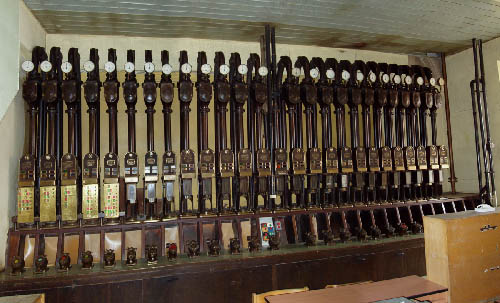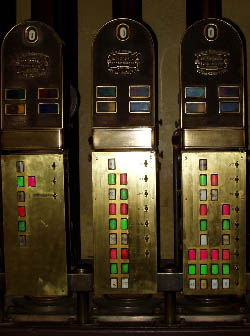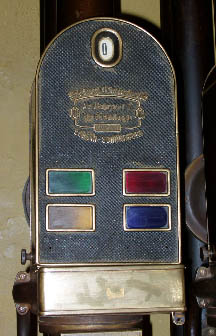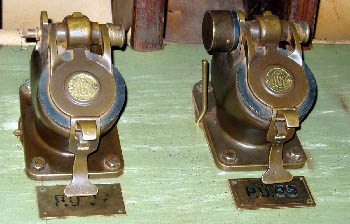This document was kindly written by Jakub Serých (Serych@panska.cz) in June 2004, following a visit to the system in the same year.
Pneumatic Tube System in Prague

View of the whole control system (montage of three separate photographs).
The Prague pneumatic delivering system has five main paths equipped with switches and concentrators, and 20 other direct lines. The total length of the system is 55km. It crosses the river Vltava three times.
It was used to deliver packages with a weight of up to 3kg, with diameter up to 5cm and length up to 30cm, from any station to any other station by the means of the central system control room (illustrated). The central control room is located in a building of the main Prague Post Office (about 300m from Wenceslas Square).

Control heads of the main lines, with the buttons for programming the switches on the lines.
Paths are built using steel weld-less pipes with an internal diameter of 65mm. They are connected by cap rings, which guarantee the coaxial and air-tight connections. Tubes are embedded at a depth of 90 to 150cm, preferably under the pavements of the Prague streets. The river crossings are realized in the construction of bridges (not under the water level). Corner diameters are a minimum of 3.5m outside buildings and 2.5m inside buildings. There are many service shafts on the tube lines, which allow tubes to be disconnected in the event of deadlock of a capsule. It was possible to have up to 10 capsules on each line. You can see the capsule counter on the photographs of the control heads.

Close up view of the capsule counter and lights displaying the status of the line. The inscription on the head reads: "Mix u.Genest Aktiengesellscaft. Abt.Rohrpost u. Förderanlagen. D.R.Patent. Berlin-Schöneberg".
It was necessary to have compressors at 3km intervals along the line. These are reversible compressors connected by "T" elements to the main tubes. First they suck the air, and when the capsule advances towards the T element, the contact in the tube switches the direction of the compressor, capsule flies through the T element by the inertia. When it is behind the T element the compressor already blows air so the capsule can continue its travel. The capsule has an average speed of approximately 35km/h, which was a good speed until recently. There was an experiment in about 1970 in which they tried to deliver 50 telegram forms (it is the maximum capacity of the capsule) from the Prague main post office to the Prague castle post office by the messenger, by telex system (with the fastest operator - winner of the typewriter competitions), and by the pneumatic tube system. The tube system was the absolute winner, taking 8 minutes to deliver the package.

Inputs for sending capsules. The right one has an automatic cover lock to protect inputing the capsule if the line is in the incoming direction (it is the small cylinder on the left upper corner of the right input).
The system was fully functional until the floods in Prague during Summer 2002. Now it is under repair [2004], but it seems that some lines were damaged so heavily by the floods that they cannot be repaired again.